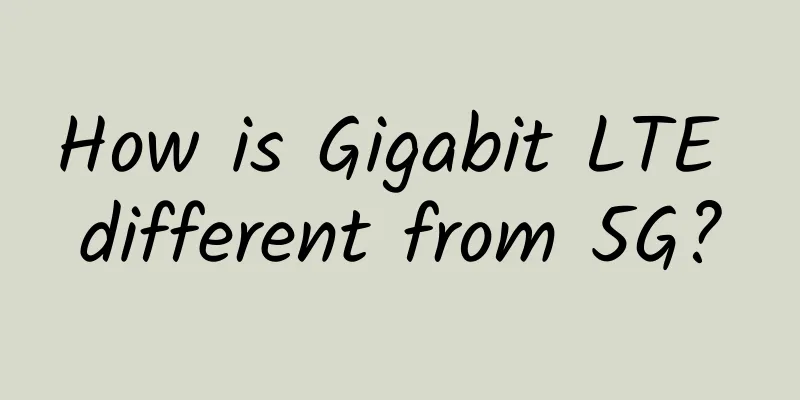How is Gigabit LTE different from 5G?

Gigabit LTE: The 4G solution for high-speed cellular broadband5G is getting a lot of attention because it’s become table stakes for consumers. Gigabit LTE is the lesser-known 4G technology that introduced uninterrupted streaming video on smartphones. It’s an evolution of 4G LTE that delivers reliable mobile broadband access at speeds exceeding wired broadband. As carriers roll out 5G at a breakneck pace, coverage is expanding rapidly. However, Gigabit LTE is still available around the world. 5G is a new technology with a new radio waveform and a new modem. Therefore, for some time, 5G will be more expensive than 4G products. The cost of new 5G chipsets will include a price premium due to all the new features in the devices. On the other hand, as 4G devices achieve economies of scale through mass deployment, prices will fall. Gigabit LTE vs. 4G LTEWith the advent of the fourth generation of mobile communication standards (4G), there is a greater focus on data transmission. Previous generations of cellular standards (2G and 3G) were centered around voice and text capabilities, catering to consumers before the advent of smartphones. For smartphones and mobile broadband communications, the LTE-Advanced (LTE-A) standard was approved in 2011 (3GPP Release 10). It offers a peak download data rate of 1 Gbps. LTE-Advanced Pro (LTE-A Pro) enhances Gigabit LTE capabilities. 3GPP approved this standard around 2015 with Release (Rel) 13. LTE-A Pro takes 4G a step further. It offers peak download speeds in the 3 Gbps range, depending on the network's high carrier aggregation availability (LTE-A Pro allows up to 32 20-MHz carriers). Key 5G technologies and strategies that enable LTE-A Pro to demonstrate the robustness and resilience of these ultra-high-speed connections can be faster than wired broadband. These include:
Mobile network operators (MNOs) can offer higher data speeds by combining the data-carrying capacity of multiple parts of the radio spectrum (called "carriers") to send and receive data.
To increase the capacity of the radio spectrum that carries data, LAA uses the unlicensed 5 GHz band in conjunction with licensed spectrum from MNOs. The licensed spectrum is called “cleared spectrum.” No one except the licensee uses that spectrum within the licensed regional boundaries.
Quadrature Amplitude Modulation (QAM) is an efficient dual-domain coding strategy. It uses amplitude and frequency modulation to encode information in a radio waveform. The higher the QAM value, the more information the waveform can carry.
As carrier aggregation enables higher bandwidths through multiple carriers, so does MIMO with multiple antenna paths per band. Gigabit LTE networks standardize on four antennas on base stations and four on devices. These antennas increase spectral efficiency and data speeds, allowing devices to connect to the most stable available signal. Gigabit LTE and 5GWhile Gigabit LTE and 5G are similar, there are some key details that distinguish them. 5G adds new bands to the available frequencies in the sub-6 GHz range and in the ultra-high millimeter wave (mmWave) spectrum (up to 40 GHz). 4G was primarily deployed at lower frequencies (up to 2.5 GHz), with the exception of a few 3.5 GHz bands (also known as mid-band). In addition, the maximum bandwidth of the 4G spectrum is limited to 20 MHz. This means that the capacity of each 4G carrier is limited to 20 MHz. On the other hand, 5G defines a new frequency band that is 100 MHz wide. We can imagine how several operators can achieve high speeds in 5G networks. Because broadband-rich millimeter-wave cells cover a small area, they must be densely concentrated to achieve the target user experience level. The 5G experience is very different from Gigabit LTE and requires the construction of new infrastructure, which takes time. Another difference is that 5G networks can operate in two modes: standalone (SA) or non-standalone (NSA). SA means the system operates with all 5G radios and core networks. NSA uses a combination of LTE and 5G resources in a different mode. With the release of 3GPP Rel 16 in 2020, 5G becomes a reliable alternative to wired networks used in critical industrial processes. These processes are dominated by various wired and fiber-based time-sensitive networks (TSN). The ultra-reliable low-latency communication (URLLC) feature of Rel 16 specifies link reliability better than 99.9999% and latency in the millisecond range. Applications and use cases for Gigabit LTE networksThe widespread availability of Gigabit LTE and the declining cost of connectivity offer the advantage of easier adoption. Unlike 5G, it does not require the construction of new towers or the redesign of device antennas to handle the needs of mmWave or URLLC technologies. Gigabit LTE offers many of the benefits associated with 5G, such as high-speed data, to global enterprises without the design challenges. Here are some ideal use cases for Gigabit LTE:
Businesses and institutions must frequently add network connectivity to sites and locations that cannot be reached by existing infrastructure. Wired connectivity using copper or fiber can be very expensive and require long installation lead times. It is more cost-effective to deploy cellular routers to provide Gigabit LTE broadband access to these sites. In situations such as natural disasters and pop-up events, this is the only available option.
Gigabit LTE is critical in some industrial applications, such as security applications that require high bandwidth. If a business needs to monitor a remote location 24/7, Gigabit LTE is the most reliable method.
Gigabit LTE offers a cheap, efficient solution for businesses that must establish Internet connections at branch offices or temporary stores. It requires minimal setup: Carriers simply turn on an LTE router and provide connectivity in minutes.
Even if the office maintains a wired connection to the internet and the head office, Gigabit LTE can serve as a backup system. Downtime can be costly, costing small businesses about $423 per minute and large businesses about $9,000 per minute. In comparison, a Gigabit LTE backup system costs very little and can be insured for such losses. |
<<: Increasing Adoption of 5G Technology to Drive Cellular IoT Module Market
>>: Mobile Edge Computing: The True Future of 5G
Recommend
2022, 6G development continues to heat up
Development of 6G networks is gathering pace, wit...
XenSpec: $2.95/month KVM-1GB/10GB/1Gbps unlimited traffic/Los Angeles, Chicago data centers
We have shared information about XenSpec several ...
Huawei's Meng Wanzhou: 5.5G is the inevitable path for 5G network evolution
On June 28, 2023 MWC Shanghai opened, and Huawei ...
Technical Tips | Alibaba Cloud's Practical Exploration of Building Lakehouse Based on Hudi
1. Data Lake and Lakehouse At the 2021 Developer ...
How can you explain the communication protocol in such a simple way?
This article is reprinted from the WeChat public ...
Global Private 5G Network, Taking Enterprise to the Next Level!
A recent analysis by Frost & Sullivan shows t...
What functions and advantages does 5G technology bring to enterprises?
As carriers pilot fifth-generation cellular netwo...
IPv6 large-scale deployment is ready to go, and the Internet of Things may become a "killer application"
With the exhaustion of IPv4 address resources and...
What types of single-mode optical fiber are used?
What is single mode fiber? In fiber optic technol...
An article reviews the top 10 wireless network technologies that connect tens of billions of terminals
With the development of the Internet industry, pe...
How does CDN work? Do you know?
A content delivery network (CDN) is a set of serv...
[11.11] LOCVPS top up 100 yuan and get 10 yuan, all hosts are 60% off, Hong Kong VPS monthly payment starts from 22 yuan
LOCVPS officially announced the promotion during ...
Will 5G replace NB-IoT immediately after commercialization? Not really!
From May 21 to May 25, the international telecomm...
RAKsmart cloud servers start at 10% off, Hong Kong/Japan/Los Angeles/San Jose cloud servers start at 129 yuan/year
RAKsmart data center has launched the "Every...
Ftpit: $3.49/month KVM-1GB/20GB/1TB/3 data centers in Fremont, Los Angeles, and New York
Ftpit is a foreign hosting company founded in 201...



![[6.18] TmhHost 30% off on all VPS, Japan/Hong Kong/Los Angeles CN2 GIA/AS9929 monthly payment starting from 21 yuan](/upload/images/67cabea213fd6.webp)





